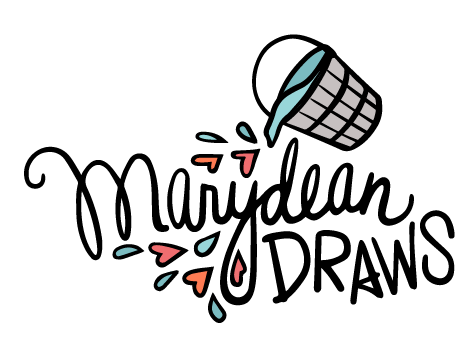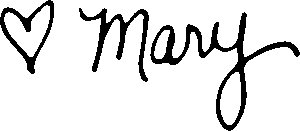

Today on the blog, things are a little different! I’m jumping into a new series that I’ve long wanted to write about, but instead of just writing it out in the safety of my thoughts, I felt God urging me to make this one a little more personal. So to do that, I recorded a video introducing this new blog series on racism. The video is below (or HERE if you don’t see it below), but I’ll include the transcript too. Make sure to check out resources I mention in the video at the end of this post.
transcript from the video:
Hey friends! Thanks for clicking on the video. I’m Mary, the artist behind Marydean Draws. I’m doing something a little bit different today. I’m recording this video, an introduction to this series about racism. I felt convicted to do a video, because on a topic that can be so fraught with a lot of feelings–it can be scary, it can feel shameful, [we can feel] angry, intimidated, fragile. I wanted it to feel more intimate. For me, it’s more comfortable to be behind the screen, behind the art, but for this, I wanted you to hear my heart and to put myself out there so you can see me talking about this if I’m asking you to talk about it with me.
So, it may be awkward, but that’s just me. So thank you for being here and being willing to listen.
Dr. Beverly Tatum wrote a book called “Why are all the Black Kids Sitting Together in the Cafeteria?” It’s kind of a classic on race. She talks about education. If you’re a teacher, I definitely recommend that book. Look her up, watch her videos. She’s amazing. I’ll put some links below.
Dr. Tatum often gives talks to big groups of people and one of the first things she asks is, “What is your first memory of race?” So I was thinking and I remember I was probably eight, and we were living in California. That’s how I remember how old I was based on where we were living at the time. We were at a grocery store with a Black family. It was a mother and her daughter. The daughter was a little younger than me and she reached out to hold my hand and I pulled it back. I don’t remember the reason being the color of her skin, at least consciously, but my mom was horrified that I didn’t want to hold this little Black girl’s hand and she kind of scolded me. I remembered it feeling confusing. I didn’t know exactly what was happening. I felt shame. And that memory has stuck with me.
I think we all have memories like that, experiences like that, and they probably all felt differently depending on your skin color and what that experience was.
The next question she [Dr. Tatum] asks after this first question is: “Did a caring adult come alongside you and talk with you about this experience and explain things clearly and comfort you and give you clarity about this experience.” She says that most of the time people say “no.”
For me, I don’t remember having a conversation with my mom. I grew up like most white families. We were not actively racist. We didn’t want to cause any harm, but we kind of had a colorblind approach. We don’t see, race is not important. And I think that the continues to be the case for many of us.
Wendell Berry wrote a book called “The Hidden Wound” and he talks about his experience of race growing up. He says that the issues of race were wrapped up in silence and that silence spoke volumes of what was underneath. And that silence became a source of great tension and anxiety.
And that’s what I feel has happened in our culture. Because we don’t talk about it we are not able to heal and move forward. That silence speaks volumes about what’s broken.
I would argue that if there’s something in our life that causes so much fear, so much shame, anger, confusion–that’s an indicator that something is broken. It’s a cry for something to be restored–in us and in the world.
The Gospel speaks to that. We need to let the Gospel speak to this issue. We already know that what the Gospel says about us is that we’re sinful. So we don’t have to cover it up. Let’s start with that. We spend so much energy trying to convince ourselves that we’re not racist, that we’re not part of the problem, that we can’t slow down and ask ourselves, “Hey, do I have any racist ideas?” “Is there any way that I have been affected by my sinful culture?”
Just to put it in context, my husband’s great-great grandfather was born a slave in Virginia. We recently found the plantation where he was a slave. That is not that far away when we think of it like that. I have slave-owning relatives. They were Alabama planters, the same generation (as my husband’s great-great-grandfather). That is not that far away. We cannot believe that we have escaped that heritage without some destructive and sinful consequences on us.
We have to start looking at this issue. So that’s why I want us to have freedom. I want us to get to the point where we can be empathetic, we can be informed, we can be courageous, we can be humble, and we can be active in the pursuit of both righteousness AND justice.
That, to me, proclaims the Gospel. We can do it in word and in deed. There is no Biblical justification for a split between faith and action. We’re reading [the book of] James in our Bible study and that point has come to me. That is an unnatural and unbiblical distinction.
So you may be wondering how it all started. Actually it all started, funny story, with Instagram. So about three years ago I was looking at my Instagram feed and I realized I wanted to diversify who I was following. Probably most of the people I was following were white like me. So I was going to find some African American women, so I found a few women to follow who were Christians.
Soon after that in July 2016, two black men were shot by police in one week. I tear up because I’m looking at their names. Their names were Philando Castile and Alton Sterling. I think Alton Sterling was a father of five.
These weren’t the first police shootings, but for the first time I saw these men’s lives through their eyes [the women I was following]. Sorry, that made me more emotional that I thought. For the first time I saw these incidents through the eyes of these women I was following. And they were grieved and they were angry. They were fearful for their husbands and their brothers and their sons. They knew that their sons, their beautiful sons, would always be perceived as more dangerous than young white boys. as more suspicious. They had to have conversations with them about being so careful about how they responded to police.
I don’t know why it hit me finally, but I realized I didn’t feel the same as they did. And it grieved me and perplexed me and caused me to question the way that I saw the world. And I wondered, “What do they see that I don’t see? What world do they live in that I don’t understand? Why did I not grieve over these lives the way that they did?
That was three years ago and that led me on a really long journey that I’m still on. I began to read a lot. I joined the Be the Bridge for Racial Unity Facebook group and that was really transformational. They provide a continuous source of resources and articles and videos. I’m still going through a lot of things they shared. I started to read our history. I read “Lies My Teacher Told Me.” The first couple chapters talk about Columbus and then slavery and reconstruction. It really set the context. The other book I read was “The Warmth of Other Suns” by Isabel Wilkerson about the Great Migration and that just changed the way I saw everything. It explains the way a lot of our cities were formed. It has so much history. It’s just jam-packed. It’s biographical. It’s just an amazing book.
So it began to change everything for me as I began to learn and as I listened to people whose experiences were different from my own.
And so I began to be convinced that this was more than I realized, way more, as a problem.
I feel compelled to write these blog posts and start this series. I don’t know how long this will be. I have several things I want to write. So I’m just asking you to come on this journey with me. I’m not finished. The more I learn, the more I realize there’s more sin in me. I think that’s the case with sin and pursuing holiness–is that there’s always more.
I am in no way setting myself up as an expert on this. In no way am I saying I understand what it’s like to be a minority. I’m definitely coming at this from White privilege. And what I mean by that is that I could walk away from this and not have to think about it as a White woman. That’s a good definition of White privilege. You can walk away if you want to. It’s not daily in your face. It’s not life or death for me.
Racism does affect me as a White person–what I mean is that the ideas of White supremacy affect me negatively. Those are things I have to sort through, but I am not experiencing oppression. I never have. So I come at this with certain blind spots. I do want to acknowledge that.
My hope is to always direct you to people who can talk about that, who are authorities on that, who have studied that history. I want to facilitate that for you. That’s kind of how I see my role.
To me, this is a family issue. This is a family of God issue. We all belong to each other. We may not go to the same churches. Our churches may be segregated, but that doesn’t mean that we’re not one body.
1 Corinthians 12: 25 says that we should have “no division in the body, but that the members may have the same care for one another.”
So I think the issue of race is a family issue.
Galatians 6:10 says, “So then, as we have opportunity, let us do good to everyone, and especially to those who are of the household of faith.”
Obviously, we should care about those outside of the church. Yes, that’s our mission field. but especially for the body of Christ, for our brothers and sisters of color.
Secondly, I think this is a Gospel issue. It’s an issue of bringing glory to God. I think so much harm is done to the name of Jesus through racism. So much harm is done through our inability to really love people and see their needs and see the way racism has affected them.
Thirdly, I think racism becomes an identity issue, a matter of how we see ourselves. We absorb the message and traditions and culture around us in ways that we don’t even understand. That message is going to be different depending on the color of your skin, so we all have to look and say, “What are we believing about ourselves that is not true?”
I hope that my intentions behind this series are clear. My intentions are not to shame anyone. A really good book I’m reading is called “White Awake” by Daniel Hill. He says it’s really helpful to distinguish between shame and guilt. Guilt is an appropriate response to sin, and guilt leads us to repentance. Guilt is actually so healthy. Shame is not healthy. Shame gets us stuck. Shame says we’re bad, not that something about us is sinful, but that we are ourselves is bad. So that’s not what I’m saying. I’m not saying any race is inherently bad–that’s just shame. We are sinful people, yes. So let’s take a look at that courageously and ask God to give us the eyes to see it, the humility to repent, and let’s go out and change the world with the Gospel.
I’m excited. I’m terrified. Feeling lots of things here, but I’m excited and I hope that you’ll join me. And you may not agree with me. That’s okay. I just hope we can all grow and see the room for growth.
If you have question about this, you can email me or leave a comment on the blog. Again, I’m not an expert, but I hope that I can walk through this with you.
Thank guys, bye!
RESOURCES MENTIONED:
Why Are All the Black Kids Sitting Together in the Cafeteria?: And Other Conversations About Race by Beverly Daniel Tatum (book)
Interview with Dr. Beverly Tatum (video)
The Hidden Wound by Wendell Berry (book)
Be the Bridge to Racial Unity Facebook Group (this is a private FB group, but you can apply to join)
Be the Bridge (organization website)
Lies My Teacher Told Me: Everything Your American History Textbook Got Wrong by James Loewen
The Warmth of Other Suns: The Epic Story of America’s Great Migration by Isabel Wilkerson
The Great Migration and the power of a single decision | Isabel Wilkerson TED Talk (video)
White Awake: An Honest Look at What It Means to Be White by Daniel Hill
Interview with Daniel Hill (video)
I’m excited to walk through this series with you! I’m thinking about artwork to supplement what we’ll be talking about that you can use as a resource as you teach and encourage others in these truths!










Looking forward to hearing more!!
I look forward to being on this growth journey!
Thanks Sarah!! Excited.
Glad you're coming along with me Diane!!
Nodded along the whole read through. I'm with you on this journey of righteousness AND justice.
Thank you Sarah!! So glad to have you with me. ♥️